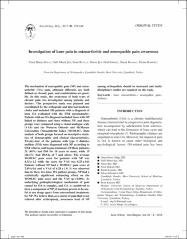| dc.contributor.author | Hatay Gölge, Umut | |
| dc.contributor.author | Şen, Halil Murat | |
| dc.contributor.author | Şen, Hacer | |
| dc.contributor.author | Göksel, Ferdi | |
| dc.contributor.author | Kaymaz, Burak | |
| dc.contributor.author | Kömürcü, Erkam | |
| dc.contributor.author | Kuyucu, Ersin | |
| dc.date.accessioned | 2020-07-06T14:55:45Z | |
| dc.date.available | 2020-07-06T14:55:45Z | |
| dc.date.issued | 2015 | en_US |
| dc.identifier.citation | Hatay Gölge, U., Şen, H. M., Şen, H., Göksel, F., Kaymaz, B., Kömürcü, E. ve Kuyucu, E. (2015). Investigation of knee pain in osteoarthritic and neuropathic pain awareness. Acta Orthopaedica Belgica, 81(4), 639-646. | en_US |
| dc.identifier.issn | 0001-6462 | |
| dc.identifier.uri | https://hdl.handle.net/20.500.12511/5405 | |
| dc.description.abstract | The mechanism of neuropathic pain (NP) and osteoarthritic (OA) pain, although different, are both defined as chronic pain, and combinations are possible. In this study, the awareness of both types of chronic pain was investigated among patients and doctors. This prospective study was planned and coordinated by the orthopedic and internal medicine clinics and included 100 patients with a diagnosis of knee OA evaluated with the DN4 questionnaire. Patients with an OA diagnosis included those with NP linked to diabetes and those without NP, and these groups were compared using a visual analogue scale (VAS) and the Western Ontario and McMaster Universities Osteoarthritic Index (WOMAC). Data analysis of both groups focused on descriptive statistics of demographic and clinical characteristics. Twenty-four of the patients with type 2 diabetes mellitus (DM) were diagnosed with NP according to DN4 criteria, and began treatment. Of these patients, 21 (84%) had DM for 10 years or more, while 19 (86.4%) had HbA1c of 7 and above. The average WOMAC pain score for patients with NP was 4.33 ± 1.2 while the score for VAS was 8.25 ± 0.8. Patients without NP had a WOMAC pain score of 2.49 ± 0.6 and a VAS of 6.28 ± 1.8. It was observed that in these two knee OA patient groups, NP had a statistically significant enhancing effect on the WOMAC pain score and the VAS (p < 0.001). As underlying pathophysiological mechanism of pain caused by OA is complex, and OA is considered to have a component of NP, it has been proven to be useful to use drugs apart from conventional treatments for NP. We believe that, as a source of pain that is not relieved after arthroplasty, awareness level of NP among orthopedists should be increased and multidisciplinary studies are required on this topic. | en_US |
| dc.language.iso | eng | en_US |
| dc.publisher | Acta Medica Belgica | en_US |
| dc.rights | info:eu-repo/semantics/openAccess | en_US |
| dc.subject | Knee Osteoarthritis | en_US |
| dc.subject | Neuropathic Pain | en_US |
| dc.subject | Diabetes | en_US |
| dc.title | Investigation of knee pain in osteoarthritic and neuropathic pain awareness | en_US |
| dc.type | article | en_US |
| dc.relation.ispartof | Acta Orthopaedica Belgica | en_US |
| dc.department | İstanbul Medipol Üniversitesi, Tıp Fakültesi, Cerrahi Tıp Bilimleri Bölümü, Ortopedi ve Travmatoloji Ana Bilim Dalı | en_US |
| dc.authorid | 0000-0003-3976-9530 | en_US |
| dc.identifier.volume | 81 | en_US |
| dc.identifier.issue | 4 | en_US |
| dc.identifier.startpage | 639 | en_US |
| dc.identifier.endpage | 646 | en_US |
| dc.relation.publicationcategory | Makale - Uluslararası Hakemli Dergi - Kurum Öğretim Elemanı | en_US |
| dc.identifier.wosquality | Q4 | en_US |
| dc.identifier.scopusquality | Q2 | en_US |


















